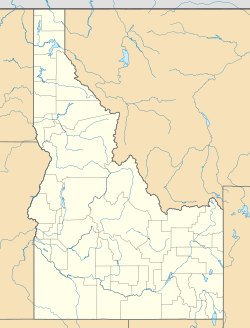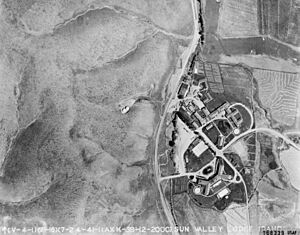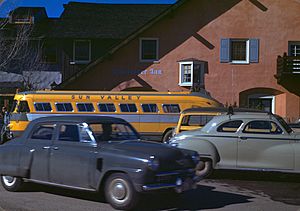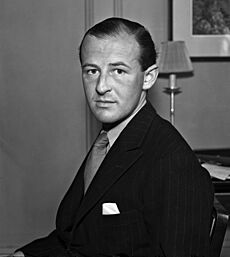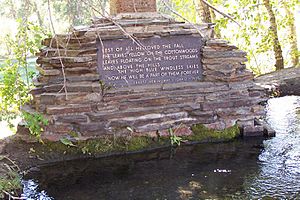Sun Valley, Idaho facts for kids
Quick facts for kids
Sun Valley, Idaho
|
|
|---|---|
|
City
|
|
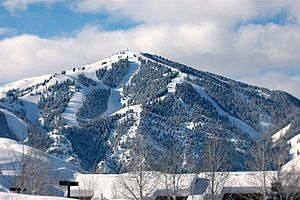
View of Bald Mountain from
Sun Valley Lake in January 2006 |
|
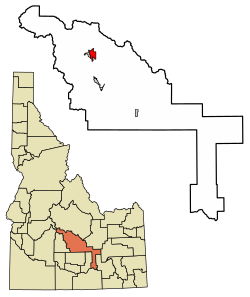
Location in Blaine County, Idaho
|
|
| Country | United States |
| State | Idaho |
| County | Blaine |
| Founded | December 21, 1936, 89 years ago |
| Incorporated | 1947 |
| Area | |
| • Total | 9.58 sq mi (24.80 km2) |
| • Land | 9.56 sq mi (24.77 km2) |
| • Water | 0.01 sq mi (0.03 km2) |
| Elevation | 6,076 ft (1,852 m) |
| Population
(2020)
|
|
| • Total | 1,783 |
| • Density | 155.36/sq mi (59.99/km2) |
| Time zone | UTC−7 (Mountain (MST)) |
| • Summer (DST) | UTC−6 (MDT) |
| ZIP Codes |
83353–83354
|
| Area code(s) | 208, 986 |
| FIPS code | 16-78850 |
| GNIS feature ID | 2412003 |
Sun Valley is a special resort city in the western United States. It is located in Blaine County, Idaho, right next to the city of Ketchum. The city is nestled in the beautiful Wood River valley. In 2020, about 1,783 people lived there. Sun Valley is about 5,920 feet (1,804 meters) above sea level.
When people talk about "Sun Valley" for skiing, they usually mean the amazing alpine ski area. This area includes Bald Mountain, which is the main ski mountain near Ketchum. There's also Dollar Mountain, which is perfect for beginners and those who are still learning. Bald Mountain, often called "Baldy," is great for more experienced skiers. Its top is 9,150 feet (2,789 meters) high, with a drop of 3,400 feet (1,036 meters). Dollar Mountain is 6,638 feet (2,023 meters) high and has a drop of 628 feet (191 meters).
The name "Sun Valley" can also mean the whole area around the city. This includes nearby Ketchum and the Wood River Valley stretching south to Hailey and Bellevue. This region has been a favorite spot for famous people since the late 1930s, thanks to writer Ernest Hemingway.
If you want to visit, you can fly into Friedman Memorial Airport (SUN) in Hailey. It's about 15 miles (24 km) south of Sun Valley. The area is also close to the Sawtooth National Recreation Area. You can reach it by driving over Galena Summit on State Highway 75, which is called the Sawtooth Scenic Byway.
Contents
The History of Sun Valley
How Sun Valley Began
The very first winter resort in the U.S. was created by W. Averell Harriman. He was the chairman of the Union Pacific Railroad. He wanted more people to ride his trains in the Western United States. Trains like the City of Portland and Portland Rose would take people to Shoshone. From there, buses would carry them to Sun Valley.
The success of the 1932 Winter Olympics made more people interested in winter sports, especially skiing. Harriman, who loved to ski, believed Americans would enjoy a mountain resort like those in the Swiss Alps, such as St. Moritz.
In the winter of 1935–36, Harriman asked an Austrian sportsman, Count Felix von Schaffgotsch, to find the perfect spot for a winter resort in the Western U.S. The Count looked at many places, including Mount Rainier and Yosemite.
He was about to give up when a railroad worker in Boise mentioned that the train line to Ketchum cost a lot to clear snow. The Count decided to check it out.
Schaffgotsch was very impressed by Bald Mountain and the mountains around it. He liked the good snowfall, lots of sunshine, moderate height, and no strong winds. He chose it as the best place. Harriman agreed after visiting. They bought the Brass Ranch for a low price and started building. The resort was built in just seven months for $1.5 million.
A publicist named Steve Hannagan called the resort "Sun Valley." He came up with the famous saying: "Winter sports under a summer sun." The main building of the new resort was the Sun Valley Lodge, which opened on December 21, 1936.
The Lodge had 220 rooms and was shaped like an X. Its outside walls looked like wood but were actually concrete. The Swiss-style Sun Valley Inn (first called the "Challenger Inn") and a small village also opened in 1937. Hannagan wanted swimming pools so people wouldn't think skiing was too cold.
Both the Lodge and the Inn have round, heated outdoor swimming pools. Hannagan designed them this way so they would be photographed a lot, giving the resort free advertising. And it worked!
The First Chairlifts
The world's first chairlifts were put in at Sun Valley on Proctor and Dollar mountains in the fall of 1936. These lifts are no longer there, but you can still see parts of the Proctor Mountain chairlift base. There's a sign that says it was the site of the world's first chairlift. Also, the original building for the Dollar Mountain chairlift operator is still standing.
The idea for the chairlift came from an engineer who remembered conveyor belts used to load bananas onto ships. These single-seat chairlifts were designed in Omaha in the summer of 1936. Chairlifts quickly replaced older ways of getting up the mountain, like rope tows. The original Proctor Mountain Ski Lift is now a historic landmark.
Famous Visitors
Famous writer Ernest Hemingway finished his book For Whom the Bell Tolls while staying at the Lodge in 1939. Averell Harriman invited Hemingway and other celebrities, especially from Hollywood, to help make the resort popular.
Many stars visited often, like Gary Cooper, Clark Gable, Errol Flynn, Lucille Ball, Marilyn Monroe, and members of the Kennedy family. Hemingway lived in the area part-time for twenty years and is buried in the Ketchum Cemetery. The Hemingway Memorial, built in 1966, is near the Sun Valley Lodge. You can still visit places connected to Hemingway today.
Sun Valley was even shown in the 1941 movie Sun Valley Serenade. It starred Sonja Henie and Glenn Miller's band. Scenes were filmed at the resort. Later, in 1958, the cast of "I Love Lucy" filmed an episode of their show on Bald Mountain.
In 1971, Apollo 15 astronaut Jim Irwin said the Moon's surface looked like Sun Valley when he stepped on it!
Other famous people who have lived in the area include Adam West (who played Batman), Scott Glenn, Richard Dreyfuss, Clint Eastwood, and Janet Leigh. Arnold Schwarzenegger also visits Sun Valley often and has a home in Ketchum. There's even a ski run named after him!
Sun Valley During World War II
During World War II, Sun Valley resort closed in 1942. It was turned into a hospital for the U.S. Navy to help injured soldiers. It reopened to the public in December 1946.
Changes Over the Years
After the war, the Union Pacific Railroad became less interested in the resort. In 1964, they stopped train service to Ketchum. That November, the resort was sold to the Janss Investment Company. This company was led by Bill Janss, a former Olympic ski team member.
During the time Bill Janss owned Sun Valley (1964–1977), new areas like Warm Springs and Seattle Ridge were developed. Many new homes and condos were built. Seven new chairlifts were added, and the number of ski trails grew from 33 to 62. Snowmaking was also started in 1975.
The original Seattle Ridge chairlift was put in in 1976. Bill Janss also has a ski run named after him, called "Janss Pass."
In 1977, Bill Janss sold the resort to Earl Holding, a businessman from Utah. Holding bought Sun Valley for about $12 million. At first, some locals were worried, but Holding proved he wanted to improve the resort for the long term. One of his first changes was replacing an old single-seat chairlift with a triple one.
Under Earl Holding's ownership, many big improvements were made to the mountain. They added lots of snowmaking and grooming. They also put in high-capacity chairlifts and built four impressive day lodges. The resort's golf course was also redesigned.
In the late 1980s and early 1990s, snowmaking was greatly expanded on Bald Mountain. Three high-speed quad chairlifts were installed in 1988.
New, beautiful day lodges were built at the base of Warm Springs (1992), at the Seattle Ridge summit (1993), and at the River Run base (1995). These lodges are made of logs, river rock, and glass.
In 2009, the resort added the "Roundhouse Express Gondola" on Bald Mountain. This gondola takes skiers and non-skiers from the River Run Base to the Roundhouse Restaurant, which is halfway up the mountain. The restaurant was built in 1939 and was updated in 2010 to be open all year.
Sun Valley also expanded in 2021, adding 380 acres (1.5 km²) of new terrain and a new high-speed chairlift called Broadway.
Earl Holding passed away in 2013. His family continues to run the resort.
Ski Racing History
Before the World Cup races started, the Harriman Cup at Sun Valley was one of the most important ski races in North America. These races were the first big international ski competitions in North America, starting in 1937. The first few races were held in the Boulder Mountains. From 1940, the Harriman Cup was held on the Warm Springs side of Bald Mountain.
In March 1975 and 1977, Sun Valley hosted World Cup ski races. These included slalom and giant slalom events for both men and women.
Sun Valley is still a popular place for ski races. It hosted the U.S. Alpine Championships in 2016 and 2018.
Many Olympic medalists are from Sun Valley, including Gretchen Fraser, Christin Cooper, Picabo Street, snowboarder Kaitlyn Farrington, and disabled skier Muffy Davis. All five have ski runs named after them on Bald Mountain!
Sun Valley is scheduled to host the World Cup finals in March 2025.
Culture and Arts
The non-profit Sun Valley Museum of Arts (SVMoA) started in 1969. It became an official non-profit in 1971. It offered workshops, talks, and art shows by famous artists. Later, the museum got its main building in nearby Ketchum.
Sun Valley also hosts the Sun Valley Film Festival, where movies are shown.
The annual Sun Valley Writers' Conference (SVWC) began in 1995. It brings together famous writers and thinkers each year.
In 2018, The Argyros Performing Arts Center opened in downtown Ketchum. This theater can seat 450 people and has hosted many well-known artists and performers.
Sports for People with Disabilities
The Sun Valley area has many year-round sports programs for people with disabilities. These include Higher Ground Sun Valley, Wood River Ability Program, and Sage Brush Equine Training Center for the Handicapped. There's also Camp Rainbow Gold, a program for kids with cancer.
Sun Valley's Layout
Sun Valley city is split into two parts by a small mountain saddle. The northern part has the famous Sun Valley Lodge, Inn, and a "village" with shops and condos. It also has the original 18-hole golf course. This area is simply called "Sun Valley."
The southern part is called Elkhorn. It's next to Dollar Mountain and has its own condos and an 18-hole golf course. This area looks a bit drier, with more sagebrush. It was first developed in 1972.
Next to Sun Valley is the older city of Ketchum. It's just a mile downstream from the Sun Valley Lodge. Ketchum has a historic town center and lands near Bald Mountain.
The Sun Valley/Ketchum CVB (Convention and Visitors Bureau) provides information about events and helps with vacation planning for the whole area.
In 2005, the Dalai Lama visited Wood River High School in Hailey. He gave a speech about understanding and friendship.
Geography and Climate
Sun Valley covers about 9.89 square miles (25.61 square kilometers). Most of this is land, with a very small amount of water.
Weather in Sun Valley
Sun Valley has a dry-summer humid continental climate. This means it has warm summers and cold, snowy winters. Because of its high altitude and dry air, the temperature can change a lot between day and night. In summer, days can be hot, but nights can get close to freezing. In winter, nights are often below zero, but days are usually around freezing.
| Climate data for Sun Valley, Idaho | |||||||||||||
|---|---|---|---|---|---|---|---|---|---|---|---|---|---|
| Month | Jan | Feb | Mar | Apr | May | Jun | Jul | Aug | Sep | Oct | Nov | Dec | Year |
| Mean daily maximum °F (°C) | 30.0 (−1.1) |
35.9 (2.2) |
40.2 (4.6) |
52.1 (11.2) |
63.9 (17.7) |
71.3 (21.8) |
82.5 (28.1) |
81.6 (27.6) |
72.3 (22.4) |
60.5 (15.8) |
44.0 (6.7) |
32.4 (0.2) |
55.6 (13.1) |
| Mean daily minimum °F (°C) | 0.3 (−17.6) |
3.6 (−15.8) |
9.5 (−12.5) |
21.5 (−5.8) |
29.2 (−1.6) |
34.5 (1.4) |
38.3 (3.5) |
37.0 (2.8) |
29.9 (−1.2) |
22.8 (−5.1) |
14.4 (−9.8) |
3.6 (−15.8) |
20.4 (−6.4) |
| Average precipitation inches (mm) | 2.59 (66) |
1.61 (41) |
1.17 (30) |
0.96 (24) |
1.61 (41) |
1.67 (42) |
0.73 (19) |
0.84 (21) |
0.89 (23) |
0.93 (24) |
1.64 (42) |
2.61 (66) |
17.25 (439) |
| Average snowfall inches (cm) | 36.0 (91) |
19.0 (48) |
13.8 (35) |
4.0 (10) |
1.4 (3.6) |
0 (0) |
0 (0) |
0 (0) |
0.5 (1.3) |
2.3 (5.8) |
12.1 (31) |
32.0 (81) |
121.1 (306.7) |
Population Facts
| Historical population | |||
|---|---|---|---|
| Census | Pop. | %± | |
| 1950 | 428 | — | |
| 1960 | 317 | −25.9% | |
| 1970 | 180 | −43.2% | |
| 1980 | 545 | 202.8% | |
| 1990 | 938 | 72.1% | |
| 2000 | 1,427 | 52.1% | |
| 2010 | 1,406 | −1.5% | |
| 2020 | 1,783 | 26.8% | |
| U.S. Decennial Census | |||
People in Sun Valley (2010 Census)
In 2010, there were 1,406 people living in Sun Valley. They lived in 622 households, with 367 being families. The city had about 142 people per square mile (54.8 per square kilometer). There were 2,597 housing units.
Most of the people (96.4%) were White. A small number were African American, Native American, or Asian. About 4.6% of the people were Hispanic or Latino.
About 15.4% of households had children under 18. Many households (53.5%) were married couples. The average household had 1.95 people, and the average family had 2.45 people.
The average age in the city was 53.9 years. About 11.5% of residents were under 18, and 30.1% were 65 or older. The population was almost equally split between males (50.8%) and females (49.2%).
Education in Sun Valley
The Blaine County School District manages all the schools in the county.
The local schools for kids are:
- Ernest Hemingway STEAM School (for grades K-5)
- Wood River Middle School
- Wood River High School
The county is also connected to the College of Southern Idaho.
Television
- RSN, Ch. 14
Images for kids
See also
 In Spanish: Sun Valley (Idaho) para niños
In Spanish: Sun Valley (Idaho) para niños



